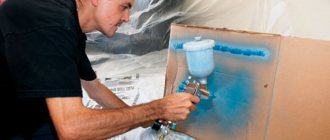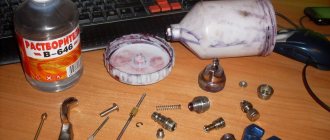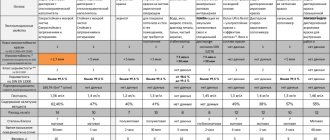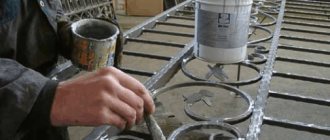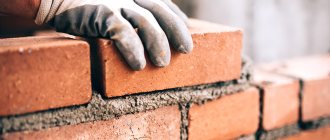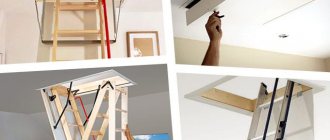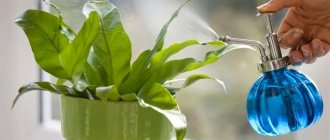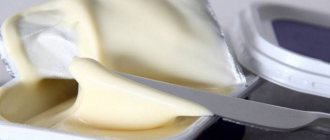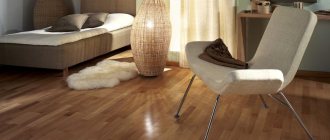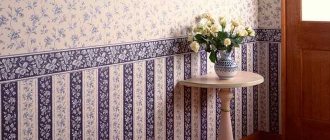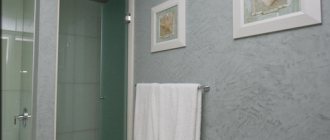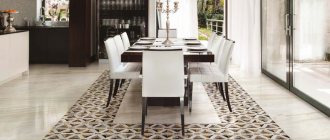To paint surfaces made of brick, concrete, wood and metal, various devices are used, including sprayers that function in different ways. Ultimately, painting jobs are virtually the same, but there are differences in energy consumption and performance.
Below we will talk about such tools in more detail, and in addition, we will watch the thematic video in this article as a supplement.
Combination pistol OPTIMA 2100
Design features and operating procedure of the standard device
The design of a typical spray gun includes the following main elements:
- container for dye;
- spray gun;
- pressure control device;
- nozzle with filter for dye;
- air head.
In addition to all these units, individual models can be equipped with (or require the purchase of) a compressor with a receiver or an electric pump, a battery or a regular power cord with a plug.
Despite some differences in design, the operation of all sprayers is identical - blowing paint and varnish materials out of the paint container in the form of a continuous cloud of spray. This is the job of a piston, pump or compressor that forces the substance through a nozzle using pressure.
The spray gun has two channels:
- for air (closed by valve);
- for paint (closed with a needle).
The structure of a pneumatic paint sprayer Source 4ertim.com
Lightly pressing the trigger results in the release of compressed gas. Deeper pressing moves the needle and releases the dye, which, mixed with the blown air currents, is sprayed into a cloud.
Releasing the trigger causes the return spring to fire and the needle to close the paint supply hole. Then the air injection stops. This sequence leads to uniform spraying of paint and varnish substances even in the first and last moments of work, preventing the occurrence of drips and droplets.
Overview characteristics of spray guns
Spray guns for painting walls and ceilings are designed for uniform distribution of water-based building materials by spraying. As a rule, the tool is used when working with varnishes and paints. Primers are applied less frequently, since it creates not an impregnating, but an opaque layer.
Regarding the design, the model range may have significant differences. However, the principle of operation of the paint sprayer is identical:
- working fluid is taken from the reservoir;
- the composition is pumped to the nozzle;
- under pressure through a stationary or replaceable nozzle, the flow is split into small drops, which are transferred through the air to the base being treated.
Based on this, the following advantages of using a spray gun for painting walls :
- Experience . In order to accurately and efficiently paint objects or structures with an equal layer of thickness using a brush or roller, it takes relatively more time than with a sprayer. The automated device requires a few minutes and attentiveness to master.
Decorative painting with “stains” from a brush Source avalremont.ru
- Result . After working with the paint sprayer, the resulting coating will be continuous, uniform and without streaks or smudges. To achieve this quality using a roller or brushes, you need to choose the right tool for a particular paint material, often more than one. Experience and knowledge regarding the nuances of coating formation and the characteristics of each type of bristle or fur coat are also important.
- Deadlines . Using the spraying method, painting is carried out noticeably faster than with compact manual analogues. This is especially true for finishing rooms with high ceilings and large structures. For comparison, the speed of a roller in the hands of a master is approximately 2–4 times lower than that of an automatic device. There are models with which you can paint up to 400 square meters. meters per hour. And this takes into account not the classic two-layer coating, but the necessary three-layer approach.
The master notes several shortcomings. But they are not so significant compared to the advantages. Among the main disadvantages are the cost of the tools, a more complex device and rules of use. Also, when working with some models, paint loss occurs. But in total this has practically no effect on material consumption.
Spraying paintwork Source pbs.twimg.com
Types of spray guns
Before choosing a spray gun, it is advisable to familiarize yourself with their types in order to understand their fundamental differences.
Mechanical operating principle
They are characterized by low accuracy and performance, therefore they are recognized as the weakest in the family. For this reason, such models will be significantly cheaper than their analogues. They are often purchased to solve a simple one-time task (for example, whitewashing). A mechanical spray gun uses the principle of a conventional pump. Several pulls on the trigger pump air, and when the desired pressure is reached, a valve opens, releasing the dye.
Manual piston spray gun Source hohol1.ru
Strengths:
- elementary design;
- satisfactory color quality;
- application does not require special knowledge and skills;
- cheapness.
Weak sides:
- constant manual air pumping is required;
- strong dispersion of the suspension, large loss of material.
Pneumatic principle
The operation of such a spray gun is based on the use of a compressor to pump air and release paintwork materials under pressure. Therefore, they are made mainly from lightweight and durable materials (aluminum). The container for the dye can be internal (with a volume of up to 2 liters) and external, which is connected using a hose. In the latter case, the volume is practically limited only by the displacement of the paint container used (bucket, barrel).
Strengths:
- good quality of painting;
- use of any painting materials;
- use of external tanks of any volume;
- simplicity and convenience.
Weak sides:
- average suspension dispersion, average material loss;
- quite high cost, since this is a professional type of equipment.
Appearance of a pneumatic spray gun Source vash.market
Electric air principle
Spraying of substances with such a device occurs not using pressure, but using a pump. The electric spray gun for painting works from a regular outlet, is quite compact and easy to use, disassemble and assemble. The weight of the device without paint ranges from 1.5 to 2.5 kg. The capacity for paints and varnishes does not exceed 1 liter. These qualities make this device a leader among home craftsmen.
Strengths:
- ease of use due to portability and light weight;
- fairly simple maintenance;
- comes with a large number of attachments;
- has good performance;
- low cost.
Weak sides:
- high noise during use;
- The quality of painting is slightly inferior to pneumatic sprayers.
See also: Catalog of companies that specialize in finishing and paintwork materials.
Electric plunger (airless) principle
The operation of such models is based on pushing the emulsion outward with a special piston (plunger). The absence of an air component minimizes overspray and waste of paint, but the quality of painting will not be the highest.
Airless spray gun model Source bmlink.com
A huge number of models with different characteristics allow you to use these devices in home and industrial environments. Their main advantage is the ability to remove paintwork materials directly from a can using a special hose.
Strengths:
- ease and convenience of use;
- ease of cleaning and maintenance;
- good performance;
- economy;
- average cost.
Weak sides:
- the quality of painting is not high;
- limited use of paints and varnishes (only synthetic and acrylic).
Battery principle
Essentially, this is the same electric spray gun for all types of paint, only it is not powered from the mains. In terms of convenience and compactness, it is similar to a manual screwdriver.
Strengths:
- compactness;
- Ease of use;
- a large number of attachments;
- not perfect, but satisfactory paint quality.
Weak sides:
- the need for periodic recharging;
- the cost is higher than network analogues.
Cordless spray gun Source graco.com
Popular models
Today, there are several manufacturing companies on the construction products market that produce paint sprayers. Components may differ from each manufacturer. Sometimes they offer the tool itself, a fitting for connecting a hose and a filter to strain the paint. Others additionally have an adapter for the tank, maintenance keys, filters, seals, gaskets, cleaning brushes, stands, lubricants, etc.
The most famous manufacturers:
- Sata. The company is considered a leader in the market of professional and manual spray guns. The models are of high quality. The torch will be homogeneous and uniform. The transfer quality of paint and varnish products is high. Excellent for facade surfaces.
- Walcom. Models from this manufacturer are used in various industrial sectors for finishing painting. Refers to high category equipment that has been tested at every phase of the production process. All models have standard gearboxes, pressure gauges, filters to filter paint during operation, additional springs and gaskets. The kit also contains oil for lubrication, brushes for cleaning, and keys for maintenance.
- Bosch. Models from this manufacturer are distinguished by high-quality and efficient application of paint and varnish material to the selected surface. Such devices are actively used not only in industry, but also in residential premises, carpentry, and car service. The spray gun is universal. It is capable of spraying even very thick formulations. Has a system for monitoring and regulating fluid flow. A special filter is attached to it in order to quickly clean the composition from impurities. The device is stable due to the presence of a special supporting surface. The most popular models are PFS 55, PFS 65 and PFS 105 E.
- Wagner. This manufacturer has been considered highly specialized for many years. The spray guns from this company are very convenient. Are powerful. Used for industrial and residential buildings. The tool is suitable for both beginners and professionals.
The best electric spray guns
It is not possible to unambiguously determine which electric spray gun is better. Each device has its own characteristics, price, and features. Each consumer chooses a specific spray gun model based on personal preferences. Therefore, the rating was compiled based on the frequency of purchases of the device and reviews from customers who have already tried the model in practice.
The best aerial models
A common feature of electric models is high-quality painting, provided by breaking paint droplets into small elements using an air jet. However, this principle involves the formation of a cloud of dye, so care must be taken to comply with safety rules.
Painting is carried out over a wide area, so unpainted parts must be covered with protective materials, secured with adhesive tape to prevent blowing away by the air flow.
Universal household spray gun Source rozetka.ua
Bosch PFS 5000E
The system pressure is pumped up by a motor with a power of 1.2 kW, and the device is equipped with a four-meter hose. Devices of this brand, made in green, imply that the device is household. However, the existing capacity for households is more than enough. In fact, this is an electric spray gun for painting a house or any other large object.
Strengths:
- the ability to use thick paints and varnishes;
- high-quality assembly of the device;
- simplified device management;
- placing the engine on wheels for easy movement;
- a large selection of attachments for different paintwork materials.
Weak sides:
- the container for the dye is small - 1 l;
- the need to frequently add paint, because paint consumption – 0.5 l/min;
- very high noise level, approximately comparable to a vacuum cleaner;
- the need to independently configure the device separately for each type of dye; moreover, the procedure for this configuration is not specified anywhere in the documents.
Carrying out painting works by spraying
In the private sector, as a rule, wallpaper or plastered surfaces are painted.
Painting walls with a spray gun Source amazon.com
Painting with water-based paint using a spray gun is carried out under pressure, so the working base must first be freed from dust, dirt and loose finishing elements. Regarding the tool, you need to make settings to work with a specific composition. It is recommended to carry out a test application of the material on newspaper or cardboard to determine the optimal distance between the nozzle and the object (range is 15-45 cm).
Video description
The test results of the WAGNER WP 585 Flexio spray gun are shown in this video:
Special BPO-350
The motor power of this spray gun is 380 W. This makes it possible to work with substances whose maximum viscosity does not exceed 60 Din. Spraying uses HVLP technology. Customer reviews indicate that the device combines high functionality, sufficient unpretentiousness and decent reliability. Such a device will not satisfy a professional, but it is good for home or country painting.
Strengths:
- light weight and simplicity of design;
- good coloring quality;
- high performance at a fairly low cost.
Weak sides:
- small nozzle size;
- small container for dye - only 0.7 l;
- high noise level.
The best airless models
The specificity of airless devices is that droplets of the coloring substance are broken into larger particles, relatively by air devices. This is enough for a household. Moreover, such devices do not form clouds of coloring substances characteristic of air models.
Airless spray gun in action Source gidpokraske.ru
Recommendations from the experts
Painting the ceiling with a spray gun involves directing the nozzles in a vertical or inclined position. In this case, the choice should be made in favor of electric models. With their help, the result is uniform, without drops or gaps.
If you are deciding which spray gun is best for painting walls and ceilings for your home, then you should consider devices that pump up pressure from 4 Atm. If you plan to work with different materials, then you need to choose devices with replaceable nozzles. Regarding the tank, a metal one will be more practical due to durability, reliability and easier cleaning (the same applies to the body). True, plastic is lighter and allows you to control the filling of the container due to the relative transparency of the walls.
Video description
This video will introduce you to the appearance and equipment of the Hammer PRZ110:
Fiolent KR1-260
An electric spray gun is cheap, but good for home use. Has a 60W motor. Works with substances whose viscosity does not exceed 80 Din. Productivity is 0.26 l/min.
Strengths:
- simplicity of design, allowing disassembly and cleaning without the use of any tools;
- flexible nozzle for painting in hard-to-reach places;
- correspondence between the size of the container for dyes and the productivity of the device, allowing you to work at maximum power for 3 minutes.
Weak sides:
- high engine noise;
- Sometimes it becomes necessary to manually adjust the piston to suck in paint from the tank.
Diagram of the pneumatic spray gun Fiolent KR1-260 Source vokruginstrumenta.ru
Why do you need to prime walls and ceilings?
If you walk up to a freshly plastered wall and run your palm over it, you will immediately realize how unstable the surface is. It's not like she's missing out. It’s just that no self-respecting wallpaper will stick to such a dusty base. And if they stick, they will very soon begin to fall off with contempt and roll back into rolls :).
Why? It’s just that particles of glue, which we used to spread the wallpaper with our usual economy, got caught on the dusty outer layer of the wall. Dust is a rather “windy” thing. She is not obliged to hold on to the surface with all her might and leaves it at every opportunity. All you have to do is blow harder and the smallest particles of plaster form a whole cloud. Then it is deposited on furnishings with a beautiful white coating.
If we glue wallpaper to such an unreliable surface, the result will not be long in coming. Moreover. Already at the gluing stage, we suddenly notice: “something clearly went wrong.” Of course, we can say that the wallpaper is “stupid” and the glue is some kind of “Chinese”, and they themselves have little experience in such matters.
But, believe me! Once you prime the walls, everything will immediately fall into place. The primer is a liquid slightly similar in color and concentration to milk. It binds dust and increases the adhesion of surfaces, that is, its ability to hold wallpaper or paint applied.
If, after priming, you run your palm over the same wall, you will be pleased to find that your hand remains clean. No dust! Even if in the near future you will not be decorating the walls in some utility rooms, for example, in the boiler room, it is still worth applying a primer. There will just be much less dust.
Briefly about the main thing
The choice of spray gun should be based on the following points:
- For one-time work where quality is not important (whitewashing), it is better to use a mechanical device.
- To reduce material consumption, a plunger device is ideal.
- In a large farm or new building, when the device is expected to be used frequently, it is better to choose an electric spray gun.
- For professional purposes (car painting, painting), it would be more correct to purchase a pneumatic version using an external paint tank.
- Work in tight spaces requires the use of battery models with good autonomy.
Each user must decide which spray gun to choose based on the expected amount of work and personal budget.
Ratings 0
FAQ
How effective is a spray gun made from a vacuum cleaner? In times when spray guns were not common, vacuum cleaners were often used instead. You can do this now - but to do this you need to spend time “re-equipping” the vacuum cleaner, and the result may not be very good. Considering the low cost of the simplest spray guns, it is more advisable to use them.
What is the difference between a spray gun and a spray gun? Only the tools used for applying paint and varnish are called spray guns, while a spray gun is a more extensive concept.
Which spray gun is preferable for whitewashing with lime? You can choose any model, as with conventional painting.
How to apply primer to walls
Next, it’s easier to show the process in pictures. In principle, there is nothing complicated there, but there are little things that it is advisable to know about before starting work.
Step 1. Pour the liquid into the tray
At this moment, you will most likely be glad for the first time that you covered the floor with film. Even the most careful novice painters can spill some of the primer when it begins to gurgle and splatter when poured into the tray from the canister.
Step 2. Dip the roller in liquid
Funny? And this is an important step. Especially when we are dipping a completely new roller. You need to give it the opportunity to soak in the primer.
Next, we begin to “roll” it along the ribbed surface of the painting tray, as if squeezing it. In this case, some of the liquid flows from the roller back into the tray:
I think you will definitely appreciate the ease of use of the tray. This is much more convenient than dipping the roller into a bucket, then trying to squeeze it off the edges, and then spilling half the liquid on the floor while you carry the tool to the wall.
Step 3. Start painting
At first, it is better to start moving the roller approximately from the middle of the wall towards the ceiling. At first, do not press the roller, otherwise the excess liquid in it will flow down the wall. We'll have to catch it. Just place the roller on the surface and roll it up:
If at this time you look at the rolling roller from above, you can see that it is “driving” a wave of liquid in front of it. This is a primer that is squeezed out of the surface of the roller:
The further we roll the roller, the less liquid remains in it. At some point, you need to lightly press the tool to squeeze out the remaining primer. However, everything in the world comes to an end. When you see that after passing the roller the wall is not wet enough, you need to dip the tool in the liquid again. Then everything is repeated from the beginning.
What is the average primer consumption per square meter
You understand that no one will give you an exact answer. Much depends on the absorbent characteristics of the surface, the degree of wetting of the plaster, which only you choose. Well, don’t forget that you will simply spill some of the product on the floor :).
In my particular case, the plastered walls consumed approximately 23 liters of soil (the total area of the premises is about 100 square meters). Thus, the soil consumption was about 1 liter per 4.3 square meters of room area (not walls!). How much you will get will be clear only when the work is finished. However, based on my indicator, you can at least roughly estimate the number of canisters that you should buy.
Just keep this in mind. This primer was enough for me for walls 3 meters high and for all ceilings. If your rooms are lower and the ceiling does not need to be primed, then, accordingly, less material is needed.
Should I spray primer?
The answer is yes, you can. But it's not necessary. The idea of using a spray gun or a simple “spray gun” was not invented by me. Every now and then “useful” advice from folk craftsmen appears on the Internet, showing how they quickly and efficiently treat walls with primer.
A novice painter uninitiated in the intricacies of the process can easily succumb to provocation. After all, everything really looks great in the video. Just a couple of minutes and the whole wall is ready.
Taking this opportunity, I decided to test the advice of the painter who performs so picturesquely in front of the camera. This required the following things:
You still need the “magic liquid” itself, a regular sprayer for plants (it was with its help that miracles were shown in the video on YouTube), and a jug to pour the soil into the bottle. You can use a funnel instead. The set is completed with a respirator and goggles to protect the respiratory tract and eyes.
In the video I watched from the Internet, the craftsman did not use protective equipment. However, all experienced painters who care about their health know how this can turn out. It's one thing to just spray primer for a couple of minutes to film a demonstration. Real work in a small and, God forbid, unventilated room is a completely different matter.
The smallest droplets of soil that inevitably form in the air during spraying will enter the lungs and eyes for quite a long time. I think there is no need to describe for a long time the harmfulness of such inhalation. Therefore, before starting the experiment, it is worth putting on protective equipment.
A hat is also included in the set of protective equipment. You can use something else instead, but in any case it is better to cover your hair. This liquid looks so harmless. But when it “gets”...
At first everything went very well. By setting the “sprinkler” to the “jet” position instead of the “spray” position, I actually began to treat the surface of the wall quite quickly.
There were only a couple of moments that spoiled the idyll: I had to add liquid quite often and change hands, giving them a little rest in turn. And so, in principle, the work was almost in full swing.
In the midst of working on the first wall, I had to pause to answer the phone. And, it seems, I spoke for only a short time—three or four minutes. But when I returned to the room and looked at the wall, I realized that “I have problems.” The area I had already sprayed was dry and looked exactly the same as the untreated surface.
It was completely unclear where processing should continue from. Deciding to check the wall with my palm, I was horrified to discover that even the already sprayed surface continued to “paint”, that is, it left a white mark on the palm. Of course, not the same as before processing, but it shouldn’t exist at all!
Alas! Applying primer using a sprayer did not pay off. The degree of surface wetting turned out to be clearly insufficient. Here and there there were completely untreated areas, although it seemed that the wall was sprayed fairly evenly. I had to pick up a good old roller and re-process the freshly sprayed surface. I agree, it takes longer and more soil is required, but the result is beyond doubt.
It’s not for nothing that experts do not recommend using sprayers for priming walls. It may indeed be faster and more economical, but in no way better.
How to set up the unit
To prime an object efficiently using a spray gun, you need to configure the spray gun properly.
Tuning involves adjusting the torch according to parameters such as size and shape.
Aspects of adjusting the spray gun:
You should first apply the product to the test surface, and then apply it to the object being treated. This helps to estimate the quantity of the composition released.
The pressure indicator is set using the adjusting head of the passage hole. The most optimal indicator is 3-5 bar.
Using the head it is possible to change the conical flare shape.
